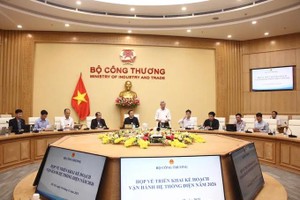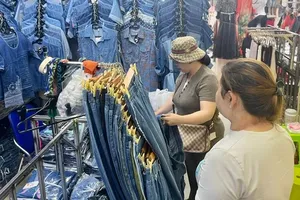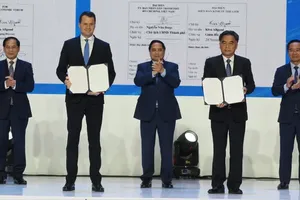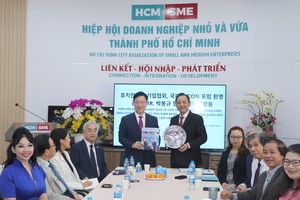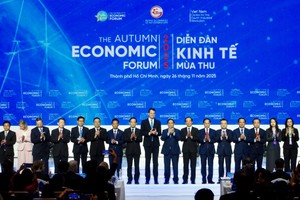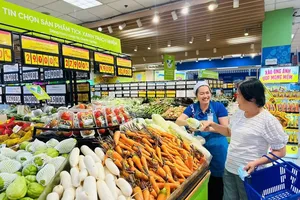
Many enterprises and building material stores are actively preparing stock to meet the needs for the peak construction season of the year. Most items, such as steel, bricks, tiles, and sanitary wares, are selling well. Noticeably, domestic construction materials are favored by consumers, thanks to reasonable prices, improved quality, and design, diverse colors, the suitability for current construction trends.
However, according to the owners of building materials stores in To Hien Thanh Street in District 10, up to now, the selling prices of most items have not increased, and some even have decreased to boost purchasing power. At present, floor tiles of domestic manufacturers range from VND80,000 to VND250,000 per square meter, depending on brands; floor tiles imported from Malaysia, Italy, and Spain range from VND400,000 to VND1.3 million per square meter. Paint manufacturing enterprises offer attractive discounts of 15-25 percent for agents and promotions for consumers. Lighting and decoration lamps have a discount ranging from 30-40 percent for each item.
Noticeably, key products in construction, such as cement, are also falling sharply by VND70,000-VND100,000 per ton. Currently, the selling prices of cement products on the market fluctuate from VND1.1 million to VND1.27 million per ton, depending on the brand. Although the demand for cement tends to increase again, the prices of cement decline because the inventory of cement remains relatively large, leading to oversupply. It is forecasted that from now until the end of this year, steel prices will remain stable with little change. In comparison with previous years, the construction material market this year is relatively stable. Many years ago, the prices of steel and cement during this time of the year usually increased, but now it is quite stable.
Experts said that production activities and consumption of building materials flourish and become vibrant again because civil construction works accelerate the completion progress before the Lunar New Year. Especially, the ministries, departments, and provinces have been rushing to urge and speed up the progress of public investment projects to disburse public investment capital following the schedule recently directed by the Prime Minister.
Despite the negative impacts of the Covid-19 pandemic, which have affected many manufacturing industries from the beginning of this year until now, the domestic steel industry has maintained a positive growth rate for ten months, and steel exports reached an impressive figure. By the end of September, the steel industry exported nearly 7 million tons of steel, bringing in over US$3.65 billion, up 44.4 percent in volume and 16 percent in value though steel prices were down 19.7 percent compared to the same period last year.
China is the largest market for Vietnam's steel products, accounting for 36.2 percent of the total volume and 28.5 percent of the total export turnover. Steel exports reached 2.53 million tons, equivalent to $1.04 billion. Cambodia follows with 17 percent, and Thailand with 8 percent in total volume and export turnover.
The latest statistics of the Ministry of Industry and Trade show that in the first nine months of this year, the cement industry exported over 28 million tons of products, bringing in more than $1.03 billion, while in the same period, the export volume was only 23.24 million tons, worth $973 million.
‘Compared to the same period last year, the output of cement and clinker for export has increased by nearly 21 percent and by 6.2 percent in value. However, the growth in value here is mainly because of export volume instead of an increase in selling prices,’ the representative of the MoIT analyzed. It is forecasted that with both current excess capacity and supply, in the coming time, the cement industry will have the opportunity to increase exports, when many countries promote import and open their doors again.
In fact, for a long time, Vietnam has mainly imported steel billets from China to serve domestic steel rolling mills, but now, due to excess capacity, steel manufacturers have to increase exports to other countries. Especially, the export of steel to the Chinese market is expected to continue smoothly, due to the country's tightening policy aiming at shutting down low-tech steelmakers. Moreover, with the implementation of the Comprehensive and Progressive Agreement for Trans-Pacific Partnership (CPTPP) and the Vietnam-EU Free Trade Agreement (EVFTA), the steel industry is expected to have more conditions to attract investment and promote production and export to new markets. These will also be positive factors, helping to raise growth expectations of the steel industry in the coming time.
However, according to some experts, the steel industry still has to compete fiercely with imported steel penetrating strongly into the Vietnamese market. Especially, the steel industry has to face safeguards in export markets, making exports difficult. Therefore, enterprises need to closely monitor information on the export situation, as well as be willing to cooperate with authorities in investigations. Steel enterprises need to improve their competitiveness and take the initiative in the sources of domestic raw materials. At the same time, they should put the effort in building a closed process from input to production, to gradually eliminate materials originating from other countries, to minimize the risk that countries think that Vietnam has evaded taxes recently.
However, according to the owners of building materials stores in To Hien Thanh Street in District 10, up to now, the selling prices of most items have not increased, and some even have decreased to boost purchasing power. At present, floor tiles of domestic manufacturers range from VND80,000 to VND250,000 per square meter, depending on brands; floor tiles imported from Malaysia, Italy, and Spain range from VND400,000 to VND1.3 million per square meter. Paint manufacturing enterprises offer attractive discounts of 15-25 percent for agents and promotions for consumers. Lighting and decoration lamps have a discount ranging from 30-40 percent for each item.
Noticeably, key products in construction, such as cement, are also falling sharply by VND70,000-VND100,000 per ton. Currently, the selling prices of cement products on the market fluctuate from VND1.1 million to VND1.27 million per ton, depending on the brand. Although the demand for cement tends to increase again, the prices of cement decline because the inventory of cement remains relatively large, leading to oversupply. It is forecasted that from now until the end of this year, steel prices will remain stable with little change. In comparison with previous years, the construction material market this year is relatively stable. Many years ago, the prices of steel and cement during this time of the year usually increased, but now it is quite stable.
Experts said that production activities and consumption of building materials flourish and become vibrant again because civil construction works accelerate the completion progress before the Lunar New Year. Especially, the ministries, departments, and provinces have been rushing to urge and speed up the progress of public investment projects to disburse public investment capital following the schedule recently directed by the Prime Minister.
Despite the negative impacts of the Covid-19 pandemic, which have affected many manufacturing industries from the beginning of this year until now, the domestic steel industry has maintained a positive growth rate for ten months, and steel exports reached an impressive figure. By the end of September, the steel industry exported nearly 7 million tons of steel, bringing in over US$3.65 billion, up 44.4 percent in volume and 16 percent in value though steel prices were down 19.7 percent compared to the same period last year.
China is the largest market for Vietnam's steel products, accounting for 36.2 percent of the total volume and 28.5 percent of the total export turnover. Steel exports reached 2.53 million tons, equivalent to $1.04 billion. Cambodia follows with 17 percent, and Thailand with 8 percent in total volume and export turnover.
The latest statistics of the Ministry of Industry and Trade show that in the first nine months of this year, the cement industry exported over 28 million tons of products, bringing in more than $1.03 billion, while in the same period, the export volume was only 23.24 million tons, worth $973 million.
‘Compared to the same period last year, the output of cement and clinker for export has increased by nearly 21 percent and by 6.2 percent in value. However, the growth in value here is mainly because of export volume instead of an increase in selling prices,’ the representative of the MoIT analyzed. It is forecasted that with both current excess capacity and supply, in the coming time, the cement industry will have the opportunity to increase exports, when many countries promote import and open their doors again.
In fact, for a long time, Vietnam has mainly imported steel billets from China to serve domestic steel rolling mills, but now, due to excess capacity, steel manufacturers have to increase exports to other countries. Especially, the export of steel to the Chinese market is expected to continue smoothly, due to the country's tightening policy aiming at shutting down low-tech steelmakers. Moreover, with the implementation of the Comprehensive and Progressive Agreement for Trans-Pacific Partnership (CPTPP) and the Vietnam-EU Free Trade Agreement (EVFTA), the steel industry is expected to have more conditions to attract investment and promote production and export to new markets. These will also be positive factors, helping to raise growth expectations of the steel industry in the coming time.
However, according to some experts, the steel industry still has to compete fiercely with imported steel penetrating strongly into the Vietnamese market. Especially, the steel industry has to face safeguards in export markets, making exports difficult. Therefore, enterprises need to closely monitor information on the export situation, as well as be willing to cooperate with authorities in investigations. Steel enterprises need to improve their competitiveness and take the initiative in the sources of domestic raw materials. At the same time, they should put the effort in building a closed process from input to production, to gradually eliminate materials originating from other countries, to minimize the risk that countries think that Vietnam has evaded taxes recently.

